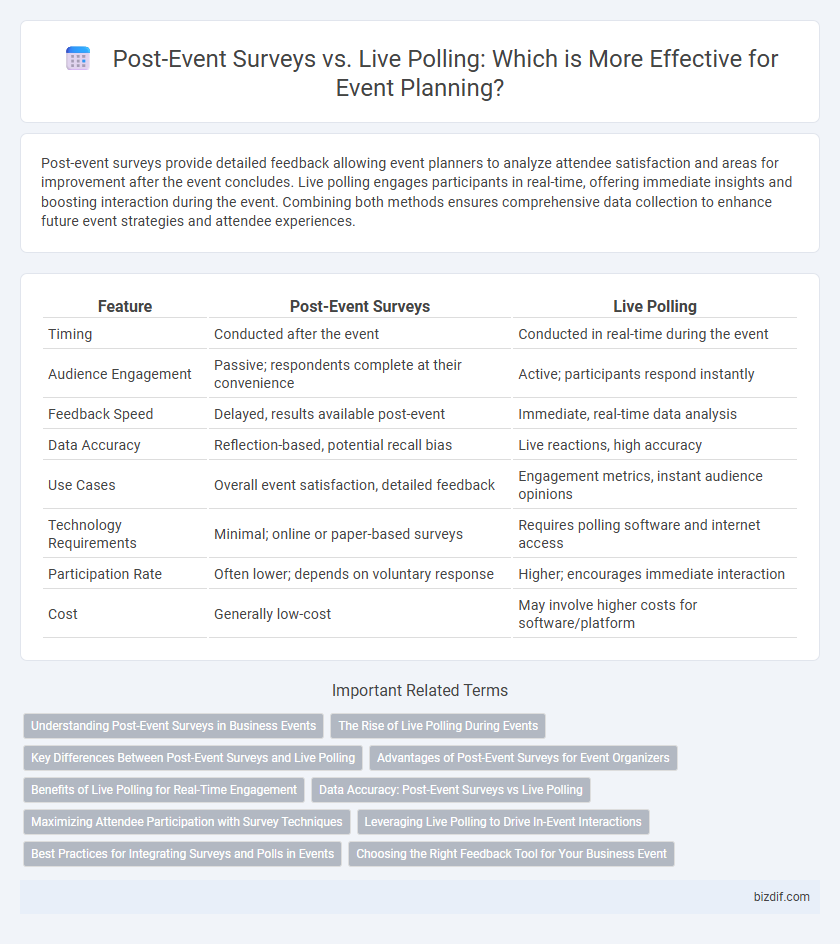Post-event surveys provide detailed feedback allowing event planners to analyze attendee satisfaction and areas for improvement after the event concludes. Live polling engages participants in real-time, offering immediate insights and boosting interaction during the event. Combining both methods ensures comprehensive data collection to enhance future event strategies and attendee experiences.
Table of Comparison
| Feature | Post-Event Surveys | Live Polling |
|---|---|---|
| Timing | Conducted after the event | Conducted in real-time during the event |
| Audience Engagement | Passive; respondents complete at their convenience | Active; participants respond instantly |
| Feedback Speed | Delayed, results available post-event | Immediate, real-time data analysis |
| Data Accuracy | Reflection-based, potential recall bias | Live reactions, high accuracy |
| Use Cases | Overall event satisfaction, detailed feedback | Engagement metrics, instant audience opinions |
| Technology Requirements | Minimal; online or paper-based surveys | Requires polling software and internet access |
| Participation Rate | Often lower; depends on voluntary response | Higher; encourages immediate interaction |
| Cost | Generally low-cost | May involve higher costs for software/platform |
Understanding Post-Event Surveys in Business Events
Post-event surveys provide detailed feedback from attendees, enabling businesses to analyze the overall success and identify areas for improvement in future events. These surveys collect valuable data on attendee satisfaction, session effectiveness, and logistical aspects, offering comprehensive insights beyond the event itself. Compared to live polling, post-event surveys allow participants to reflect thoughtfully, resulting in more accurate and actionable responses for event planners.
The Rise of Live Polling During Events
Live polling has surged in popularity at events, offering real-time audience engagement and instant feedback unlike traditional post-event surveys. This immediate interaction boosts participant involvement, allowing organizers to tailor content dynamically and gauge attendee sentiment on the spot. With mobile integration and user-friendly platforms, live polling has become a crucial tool for maximizing event impact and driving actionable insights during the event itself.
Key Differences Between Post-Event Surveys and Live Polling
Post-event surveys typically gather comprehensive feedback after an event, focusing on overall satisfaction, detailed insights, and areas for improvement. Live polling collects immediate audience reactions and opinions during the event, enabling real-time engagement and dynamic adjustments. Post-event surveys offer depth and reflection, while live polling emphasizes spontaneity and instant interaction.
Advantages of Post-Event Surveys for Event Organizers
Post-event surveys provide event organizers with comprehensive insights by allowing attendees to reflect and provide detailed feedback, leading to more accurate data collection. These surveys offer flexibility in response time, increasing participation rates and yielding diverse perspectives across different attendee segments. The data from post-event surveys enables organizers to identify long-term trends and areas for improvement, facilitating strategic planning for future events.
Benefits of Live Polling for Real-Time Engagement
Live polling enhances event engagement by capturing audience feedback instantly, enabling organizers to adapt content and address attendee questions on the spot. This real-time interaction increases participant involvement, fostering a dynamic and inclusive atmosphere. Data collected through live polls offers immediate insights, improving decision-making and driving higher satisfaction rates during events.
Data Accuracy: Post-Event Surveys vs Live Polling
Post-event surveys allow for detailed feedback collected from attendees after the event, which can result in thoughtful and comprehensive responses but may suffer from lower response rates and recall bias. Live polling captures real-time audience reactions, providing immediate and dynamic data with higher engagement but sometimes less depth and potential for spontaneous inaccuracies. Evaluating data accuracy depends on the event's goals, with live polling offering timely insights and post-event surveys delivering more reflective and nuanced information.
Maximizing Attendee Participation with Survey Techniques
Post-event surveys offer detailed feedback by allowing attendees to reflect and provide comprehensive responses at their convenience, enhancing data accuracy. Live polling engages participants in real-time, increasing interaction and immediate input during the event, which boosts overall attendee participation. Combining both methods leverages the depth of post-event surveys with the engagement power of live polling, maximizing comprehensive attendee insights.
Leveraging Live Polling to Drive In-Event Interactions
Live polling enhances event engagement by providing real-time audience feedback, enabling organizers to adjust content dynamically and foster interactive discussions. Unlike post-event surveys that gather retrospective data, live polls stimulate active participation, increasing attendee investment and satisfaction during the event. Utilizing platforms like Slido or Mentimeter for live polling can significantly boost interaction rates and deliver immediate insights for on-the-fly decision making.
Best Practices for Integrating Surveys and Polls in Events
Post-event surveys provide comprehensive feedback by allowing attendees to reflect on their experience, while live polling captures real-time opinions to boost engagement during sessions. Best practices include designing concise, targeted questions for both formats, ensuring seamless integration with event platforms to automate data collection, and analyzing quantitative and qualitative results to improve future event planning. Combining post-event surveys with live polling creates a holistic feedback loop that enhances attendee satisfaction and informs strategic decisions.
Choosing the Right Feedback Tool for Your Business Event
Post-event surveys provide comprehensive insights by allowing attendees to reflect on their experience, gathering detailed feedback over time. Live polling captures real-time reactions during the event, enhancing engagement and enabling immediate adjustments. Selecting the right tool depends on your event goals, audience interaction level, and the type of data needed to improve future events.
Post-event surveys vs Live polling Infographic

 bizdif.com
bizdif.com